Flemington (Homebush West) Public School, 1942
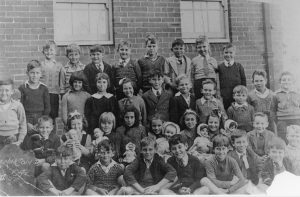
Flemington Public School (now Homebush West) class photo, 1942. Courtesy Strathfield Local Studies
As our younger residents settle into a new school year, we feature a 1942 wartime class photo from Flemington (now Homebush West) Public School. While many of the girls wear hair bows for the photo, it is likely that most of the boys are shoeless – even those wearing ties. The girls have brought their dolls to share the special occasion.
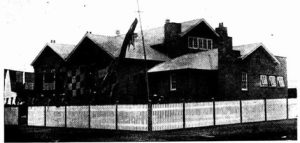
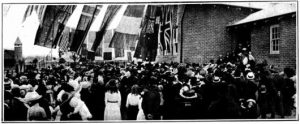
Australian Town and Country Journal 28 August 1912 p.34 https://trove.nla.gov.au/newspaper/article/263893086
The school was officially opened 30 years earlier on 24 August 1912 with Mr Carmichael, Minister of Public Instruction, unlocking the door with a silver (or golden, according to some sources) key.[1] This followed many years of local agitation for a new school.[2] A deputation of local residents and politicians had visited the Minister for Education in 1899 ‘to urge the necessity of erecting a public school at Flemington.’ [3] In 1903 V. McAdam from Hornsey Road wrote to the editor of the Daily Telegraph to plead the case of Flemington residents:
‘There are about two hundred children residing in the district, and the nearest school is at Homebush. The route on either side of the railway line between the two suburbs is a very unsafe one, as cattle are constantly driven from the saleyards, and it is only jeopardising the little ones’ lives to walk.’ [4]
Photos from Australian Town and Country Journal show that the official opening was a large, well-attended event. It was followed by a banquet for dignitaries. However, tempers became a little frayed at the banquet when Treasurer, Mr John Cann was invited to speak before MLA, Mr John Nobbs, who had campaigned for the new school for many years.[5]
Ambrose Carmichael went on to enlist, aged 49, in 1915, recruiting a thousand rifle reserve recruits to enlist with him. They became famous as Car’s Thousand.[6]
Flemington Public School had actually welcomed students a few weeks before the official opening. It must have been a big challenge for the teachers when the initial enrolment of 50 grew to 153 by the end of the first week! The following year the Flemington and West Homebush School and Progress Association presented a piano, costing £65, to the school.[7] The school was active in fundraising during World War I, donating £160 to the Mothers’ £30,000 campaign during 1915.[8]
The school continued to grow and in 1929 three new classrooms were added, with extensions also made to the assembly hall, corridors and hatroom.[9]
Fundraising continued during World War II. In 1941, young Rosemary Peatfield was one of the public school children selected to present a cheque for £5000 to the Premier for the displaced children of Britain.
‘The boys and girls of the public schools have done their best to give help to those on whom the war has brought sorrow and suffering’ said Rosemary Peatfield.[10]
Premier McKell was moved to tears.
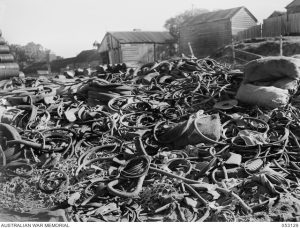
Salvaged rubber in Sydney, 3 July 1943. Courtesy Australian War Memorial.
In 1942, when the class photo was taken, the pupils of Flemington Public School embarked on another campaign to collect rubber for the war effort. Six-year-old Evelyn Watt was featured in The Sun with a pile of old tyres.[11]
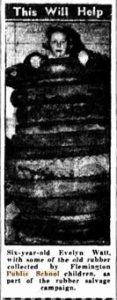
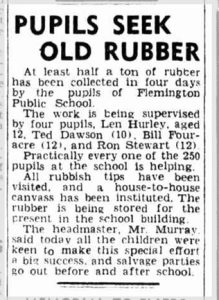
The Sun 23 July 1942 p.4 https://trove.nla.gov.au/newspaper/article/231792121
The Sun 23 July 1942 p.2 https://trove.nla.gov.au/newspaper/article/231792100
Most of the 250 students at the school were actively and enthusiastically involved, supported by headmaster, Mr Murray.
The school was renamed Homebush West Public School in 1947 and in 1953 it became a home science school for girls.
Please get in touch if you can identify any of the Flemington students in the class photo.
By J.J. MacRitchie
Local Studies Advisor
References
[1] Australian Town and Country Journal 28 August 1912 p.34 https://trove.nla.gov.au/newspaper/article/263893086[2] Daily Telegraph 23 January 1907 p.7 https://trove.nla.gov.au/newspaper/article/238034979
[3] Daily Telegraph 13 October 1899 p.8 https://trove.nla.gov.au/newspaper/article/237184388
[4] Daily Telegraph 22 Oct 1903 p.6 https://trove.nla.gov.au/newspaper/article/237586703
[5] The Cumberland Argus and Fruitgrowers Advocate 28 August 1912 p.2 https://trove.nla.gov.au/newspaper/article/86136922
[6] Bede Nairn, ‘Carmichael, Ambrose Campbell (1866–1953)’, Australian Dictionary of Biography, National Centre of Biography, Australian National University, https://adb.anu.edu.au/biography/carmichael-ambrose-campbell-5506/text9369
[7] Daily Telegraph 18 July 1913 p.4 https://trove.nla.gov.au/newspaper/article/238987934
[8] The Sun 26 August 1915 p.6 https://trove.nla.gov.au/newspaper/article/221905677
[9] Sydney Morning Herald 20 September 1929 p.7 https://trove.nla.gov.au/newspaper/article/16585741
[10] The Sun 14 October 1941 p.3 https://trove.nla.gov.au/newspaper/article/230962259
[11] The Sun 23 July 1942 p.2 https://trove.nla.gov.au/newspaper/article/231792100

1 Comment. Leave new
Thank you very much. What a find! I’d love to find some pics from 1945 -1952.It was the school I attended in those years and I remember all of those surnames mentioned as they were older siblings of my friends. In Feb 2019, I was invited to attend the opening of their new multi storey school building and enjoyed the experience of seeing the old building again. Meanwhile, thank you very much for your efforts. I have included it in the book I’ve written for the family and will keep looking for those later year pictures.